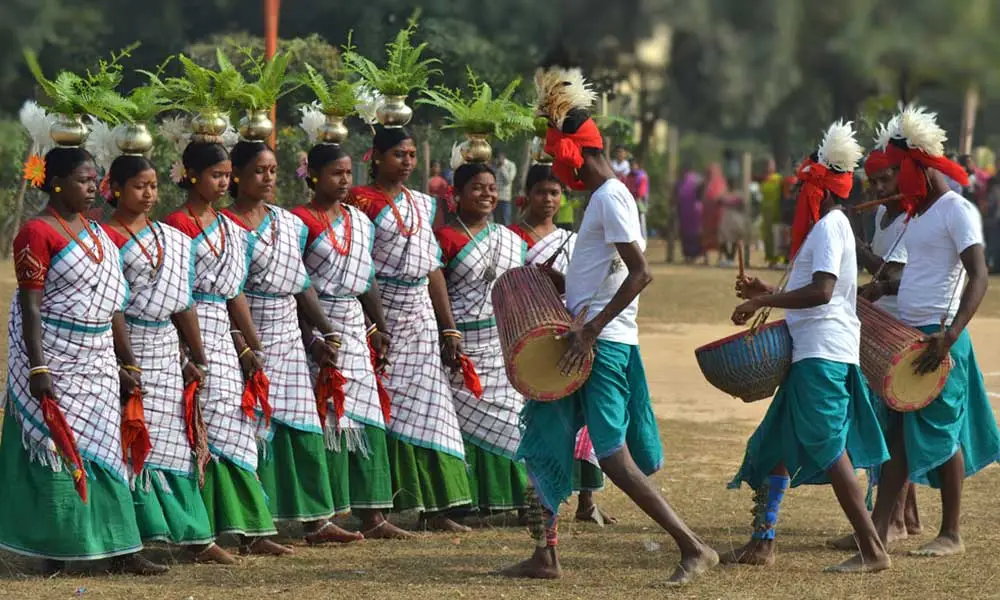About Santhal Tribal Community:
- Santhals are the third largest scheduled tribe community in India after Gonds and Bhils.
- Their greatest concentration is in the states of Bihar, Jharkhand, West Bengal, and Orissa, in the eastern part of the country.
- Language:
- Their language is Santhali, a dialect of Kherwari, a Munda (Austroasiatic) language.
- Santhali, written in OI-Chiki script, is recognised as one of the scheduled languages in the Eighth Schedule to the Constitution.
- The Santhals were a nomadic stockbefore they chose to settle on the Chotanagpur plateau.
- By the end of the 18th century, they had concentrated in the Santhal Parganas ofJharkhand (earlier Bihar). From there, they migrated to Odisha and West Bengal.
- Religion: They are nature worshippers and could be seen paying obeisance at Jaher (sacred groves) in their villages.
- Their traditional dress includes dhoti and gamuchha for men and a short-check saree, usually blue and green, for women, who generally put on tattoos.
- Various forms of marriage are accepted in Santhal society, including elopement, widow remarriage, levirate, forced (rare), and the one in which a man is made to marry the woman he has impregnated.
- Divorce is not a taboo in Santhal society. Either of the couple could divorce the other.
- Occupation:
- Most Santhals are agriculturists, depending on their farmlands or forests.
- Seasonal forest collection is one of the important sources of their subsidiary income.
- Dance (enej) and music (sereng) are integral parts of the Santal life.
- Their homes, called Olah, have a particular three-colour patternon the outer walls. The bottom portion is painted with black soil, the middle with white, and the upper with red.
- Santhal Rebellion (1855-56):
- The Santhal uprising, one of the most noted events of revolt against the British Raj, took place in 1855 and 1857.
- This was India’s first major peasant uprising fueled by the implementation of the Permanent Land Settlement in 1793.
- It was led by Sido and Kanhu and covered the regions of Bihar..
Q1: Who are Gonds?
The Gonds are the largest Adivasi Community in India and can be traced to the pre-Aryan era. The word Gond comes from Kond, which means green mountains. They are a heterogeneous group spreading over large areas from the Godavari gorges in the south to the Vindhya Mountains in the north. They live in the states of Madhya Pradesh, Maharashtra, Telangana, Andhra Pradesh, Bihar, and Odisha. The majority speak various mutually unintelligible dialects of Gondi.
Last updated on June, 2025
→ UPSC Notification 2025 was released on 22nd January 2025.
→ UPSC Prelims Result 2025 is out now for the CSE held on 25 May 2025.
→ UPSC Prelims Question Paper 2025 and Unofficial Prelims Answer Key 2025 are available now.
→ UPSC Calendar 2026 is released on 15th May, 2025.
→ The UPSC Vacancy 2025 were released 1129, out of which 979 were for UPSC CSE and remaining 150 are for UPSC IFoS.
→ UPSC Mains 2025 will be conducted on 22nd August 2025.
→ UPSC Prelims 2026 will be conducted on 24th May, 2026 & UPSC Mains 2026 will be conducted on 21st August 2026.
→ The UPSC Selection Process is of 3 stages-Prelims, Mains and Interview.
→ UPSC Result 2024 is released with latest UPSC Marksheet 2024. Check Now!
→ UPSC Toppers List 2024 is released now. Shakti Dubey is UPSC AIR 1 2024 Topper.
→ Also check Best IAS Coaching in Delhi
























